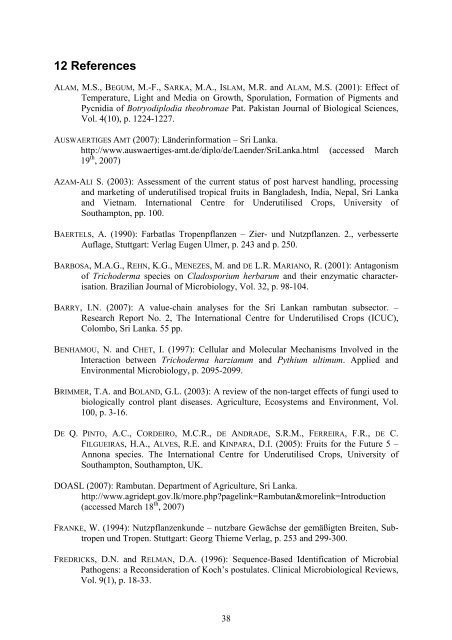Botryodiplodia sp. - Crops for the Future
Botryodiplodia sp. - Crops for the Future
Botryodiplodia sp. - Crops for the Future
You also want an ePaper? Increase the reach of your titles
YUMPU automatically turns print PDFs into web optimized ePapers that Google loves.
12 References<br />
ALAM, M.S., BEGUM, M.-F., SARKA, M.A., ISLAM, M.R. and ALAM, M.S. (2001): Effect of<br />
Temperature, Light and Media on Growth, Sporulation, Formation of Pigments and<br />
Pycnidia of <strong>Botryodiplodia</strong> <strong>the</strong>obromae Pat. Pakistan Journal of Biological Sciences,<br />
Vol. 4(10), p. 1224-1227.<br />
AUSWAERTIGES AMT (2007): Länderin<strong>for</strong>mation – Sri Lanka.<br />
http://www.auswaertiges-amt.de/diplo/de/Laender/SriLanka.html (accessed March<br />
19 th , 2007)<br />
AZAM-ALI S. (2003): Assessment of <strong>the</strong> current status of post harvest handling, processing<br />
and marketing of underutilised tropical fruits in Bangladesh, India, Nepal, Sri Lanka<br />
and Vietnam. International Centre <strong>for</strong> Underutilised <strong>Crops</strong>, University of<br />
Southampton, pp. 100.<br />
BAERTELS, A. (1990): Farbatlas Tropenpflanzen – Zier- und Nutzpflanzen. 2., verbesserte<br />
Auflage, Stuttgart: Verlag Eugen Ulmer, p. 243 and p. 250.<br />
BARBOSA, M.A.G., REHN, K.G., MENEZES, M. and DE L.R. MARIANO, R. (2001): Antagonism<br />
of Trichoderma <strong>sp</strong>ecies on Clado<strong>sp</strong>orium herbarum and <strong>the</strong>ir enzymatic characterisation.<br />
Brazilian Journal of Microbiology, Vol. 32, p. 98-104.<br />
BARRY, I.N. (2007): A value-chain analyses <strong>for</strong> <strong>the</strong> Sri Lankan rambutan subsector. –<br />
Research Report No. 2, The International Centre <strong>for</strong> Underutilised <strong>Crops</strong> (ICUC),<br />
Colombo, Sri Lanka. 55 pp.<br />
BENHAMOU, N. and CHET, I. (1997): Cellular and Molecular Mechanisms Involved in <strong>the</strong><br />
Interaction between Trichoderma harzianum and Pythium ultimum. Applied and<br />
Environmental Microbiology, p. 2095-2099.<br />
BRIMMER, T.A. and BOLAND, G.L. (2003): A review of <strong>the</strong> non-target effects of fungi used to<br />
biologically control plant diseases. Agriculture, Ecosystems and Environment, Vol.<br />
100, p. 3-16.<br />
DE Q. PINTO, A.C., CORDEIRO, M.C.R., DE ANDRADE, S.R.M., FERREIRA, F.R., DE C.<br />
FILGUEIRAS, H.A., ALVES, R.E. and KINPARA, D.I. (2005): Fruits <strong>for</strong> <strong>the</strong> <strong>Future</strong> 5 –<br />
Annona <strong>sp</strong>ecies. The International Centre <strong>for</strong> Underutilised <strong>Crops</strong>, University of<br />
Southampton, Southampton, UK.<br />
DOASL (2007): Rambutan. Department of Agriculture, Sri Lanka.<br />
http://www.agridept.gov.lk/more.php?pagelink=Rambutan&morelink=Introduction<br />
(accessed March 18 th , 2007)<br />
FRANKE, W. (1994): Nutzpflanzenkunde – nutzbare Gewächse der gemäßigten Breiten, Subtropen<br />
und Tropen. Stuttgart: Georg Thieme Verlag, p. 253 and 299-300.<br />
FREDRICKS, D.N. and RELMAN, D.A. (1996): Sequence-Based Identification of Microbial<br />
Pathogens: a Reconsideration of Koch’s postulates. Clinical Microbiological Reviews,<br />
Vol. 9(1), p. 18-33.<br />
38

















